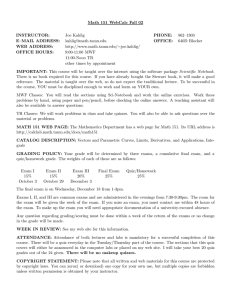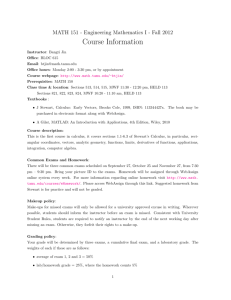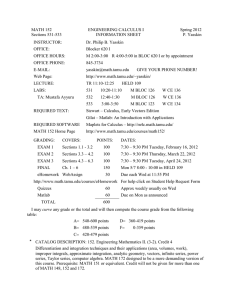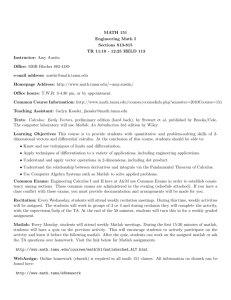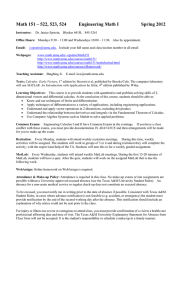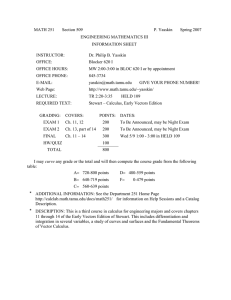Course Syllabus Math 151: Engineering Math I Spring Semester 2015 Instructor
advertisement
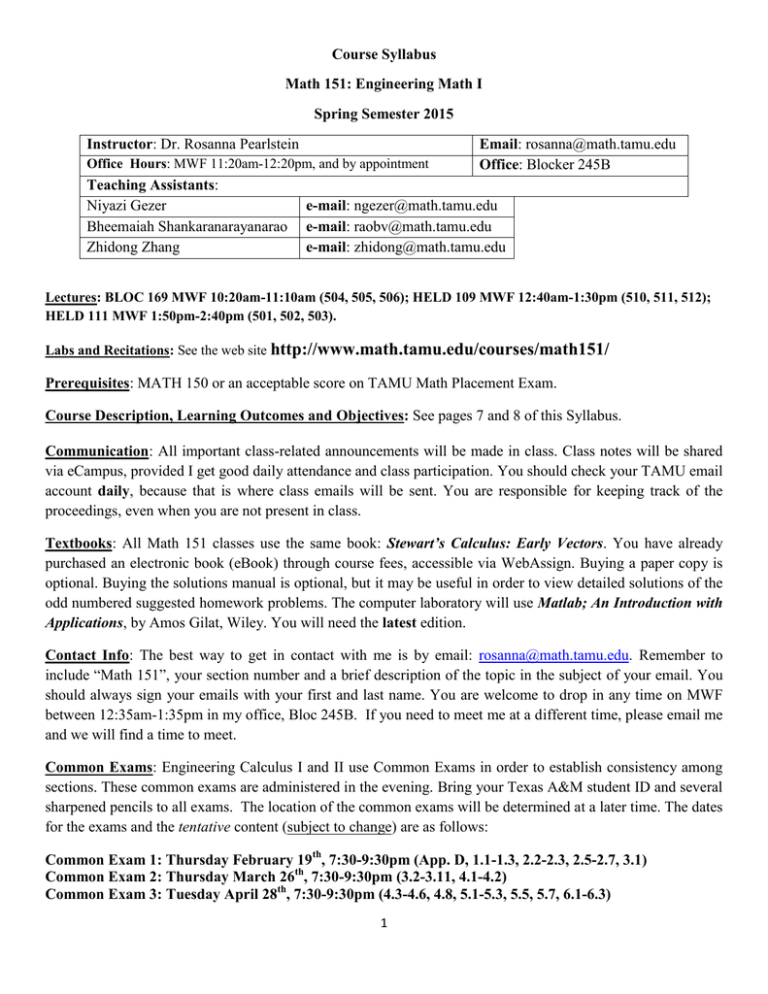
Course Syllabus Math 151: Engineering Math I Spring Semester 2015 Instructor: Dr. Rosanna Pearlstein Office Hours: MWF 11:20am-12:20pm, and by appointment Teaching Assistants: Niyazi Gezer Bheemaiah Shankaranarayanarao Zhidong Zhang Email: rosanna@math.tamu.edu Office: Blocker 245B e-mail: ngezer@math.tamu.edu e-mail: raobv@math.tamu.edu e-mail: zhidong@math.tamu.edu Lectures: BLOC 169 MWF 10:20am-11:10am (504, 505, 506); HELD 109 MWF 12:40am-1:30pm (510, 511, 512); HELD 111 MWF 1:50pm-2:40pm (501, 502, 503). Labs and Recitations: See the web site http://www.math.tamu.edu/courses/math151/ Prerequisites: MATH 150 or an acceptable score on TAMU Math Placement Exam. Course Description, Learning Outcomes and Objectives: See pages 7 and 8 of this Syllabus. Communication: All important class-related announcements will be made in class. Class notes will be shared via eCampus, provided I get good daily attendance and class participation. You should check your TAMU email account daily, because that is where class emails will be sent. You are responsible for keeping track of the proceedings, even when you are not present in class. Textbooks: All Math 151 classes use the same book: Stewart’s Calculus: Early Vectors. You have already purchased an electronic book (eBook) through course fees, accessible via WebAssign. Buying a paper copy is optional. Buying the solutions manual is optional, but it may be useful in order to view detailed solutions of the odd numbered suggested homework problems. The computer laboratory will use Matlab; An Introduction with Applications, by Amos Gilat, Wiley. You will need the latest edition. Contact Info: The best way to get in contact with me is by email: rosanna@math.tamu.edu. Remember to include “Math 151”, your section number and a brief description of the topic in the subject of your email. You should always sign your emails with your first and last name. You are welcome to drop in any time on MWF between 12:35am-1:35pm in my office, Bloc 245B. If you need to meet me at a different time, please email me and we will find a time to meet. Common Exams: Engineering Calculus I and II use Common Exams in order to establish consistency among sections. These common exams are administered in the evening. Bring your Texas A&M student ID and several sharpened pencils to all exams. The location of the common exams will be determined at a later time. The dates for the exams and the tentative content (subject to change) are as follows: Common Exam 1: Thursday February 19th, 7:30-9:30pm (App. D, 1.1-1.3, 2.2-2.3, 2.5-2.7, 3.1) Common Exam 2: Thursday March 26th, 7:30-9:30pm (3.2-3.11, 4.1-4.2) Common Exam 3: Tuesday April 28th, 7:30-9:30pm (4.3-4.6, 4.8, 5.1-5.3, 5.5, 5.7, 6.1-6.3) 1 If you have a class conflict with any of these exams, you must provide documentation as soon as possible, and arrangements will be made for you. No calculators, books or formula sheets are allowed on exams. Grade Appeals: If you believe an error has been made in grading, you have until the next class period after the exam or quiz has been handed back to let me know. Otherwise, you must accept the grade you received. Final Exam: The final exam will be a cumulative (comprehensive) exam. The day and time of the final exam are determined by the university, see http://registrar.tamu.edu/general/finalschedule.aspx#_Spring_2015. Below are the days/times as of right now. Final Exam Day Final Exam Time Class Days and Time; Sections May 11th, Monday 8:00am-10:00am MWF 10:20-11:10; 504, 505, 506 May 8th, Friday 10:30am-12:30pm MWF 12:40-1:30; 510, 511, 512 May 11th, Monday 3:30pm-5:30pm MWF 1:50-2:40; 501, 502; 503 Recitation: Every week (on Tuesday), students will attend recitation. During the first 30-35 minutes of recitation, the TAs will answer questions and solve some relevant problems on previous material. During the last 15-20 minutes, students will take a quiz on material from the previous week. Notes and calculators are not permitted on quizzes. Useful web site: http://www.math.tamu.edu/courses/math151/ Lab: Every week (on Thursdays), students will meet in the computer lab to work on computer assignments using Matlab and Maple. Assignments are posted on the web and are due at the beginning of lab on the designated day. Matlab assignments will be done in groups and each group will turn in one lab. Labs turned in after the first 10 minutes of lab will receive a 15% penalty. After this, no late work will be accepted. Web sites: http://m4c.math.tamu.edu/, http://calclab.math.tamu.edu/ and http://www.math.tamu.edu/courses/math151/ Graded Homework: Online homework is required in all math 151 classes, and will be solved online with WebAssign. For each assignment, a ‘practice’ will be available. Students are highly encouraged to work the (non-graded) practice homework before working the associated ‘graded homework’. Do not wait until the last minute to complete the online homework! All information on WebAssign, including instructions on logging in, accessing assignments, and the Student Help Request Form, is at http://www.math.tamu/courses/eHomework. The three lowest homework scores will be dropped at the end of the semester. Technical Note: In order for some features of WebAssign to work properly, you should use Mozilla Firefox and have the most updated versions of Flash and Java on your computer. Ungraded Homework: A list of suggested homework problems is attached on page 6 of this syllabus. Although not graded, these problems are highly recommended, and solving them is essential for your success in this class. Collaboration: Collaboration on homework assignments is encouraged in this course. However, copying someone else’s work and submitting it as your own is unacceptable. This act of academic dishonesty will be prosecuted in accordance with University policy. No collaboration is allowed on exams or quizzes. 2 Calculators: You are welcome to use calculators outside of the classroom to enhance your understanding of calculus. However, calculators or other electronic devices are not allowed on exams and quizzes. Laptops, Cell Phones, etc.: These should all be turned off or quiet mode during all in-class activities. Grades: The course grade will be based on: Matlab: WebAssign Homework: Quizzes: Midterm Exam Average: Final Exam: 5% 10% 10% 50% 25% The final grade ranges will be no worse than: 90% ≤ 𝐴 ≤ 100%; 80% ≤ 𝐵 < 90%; 70% ≤ 𝐶 < 80%; 60% ≤ 𝐷 < 70%; 0% ≤ 𝐹 < 60. Due to FERPA privacy issues, I cannot discuss grades over email or phone. If you have a question about your grade, please come see me in person. Make-Up Policy: No make-ups will be given without written evidence of an official University excused absence; see University Student Rules: http://student-rules.tamu.edu/. According to Section 7.3 of the University Student Rules, for an absence to be considered excused, ‘the student must notify his or her instructor in writing (acknowledged e-mail message is acceptable) prior to the date of absence if such notification is feasible. In cases where advance notification is not feasible, the student must provide notification by the end of the second working day after the absence. This notification should include an explanation of why notice could not be sent prior to the class. If no such notice is given, the rights to a make-up are forfeited.’ In addition (and also in accordance with University Student Rules), a written excuse must be presented upon return to class. Specifically, in the case of illness or injury, students are required to obtain a confirmation note from a health care professional affirming date and time of a medical office visit regarding the illness or injury and confirming the need of absence before a make-up will be given. Providing a fake or falsified doctor's note is considered academic dishonesty, will be reported to the Aggie Honor Council, and will result in a grade of “F” in the course. There is no makeup quiz, no matter what the circumstances. I will however drop the two lowest quiz scores at the end of the semester, to make up for unforeseen emergencies. Class Etiquette: During class, I will stay focused on teaching you mathematics. You are to stay focused on learning the mathematics being taught. In particular, you should stay awake throughout the class, you should not be reading a newspaper or materials from another course, you should refrain from discussion not related to class and you should not leave class early. If I feel you are being disruptive or disrespectful during class, I may have to ask you to leave. Your cell phone should be out of arms’ reach during class. Attendance: Daily, timely, lecture attendance is expected and extremely important. Although attendance is not recorded, missing even part of one class will set you behind. There is a strong correlation between class absences and poor grades. You are responsible for all material and announcements from class, even if you did not attended that class, and even if you were late. It is the student responsibility to obtain class notes from a classmate on missed material. 3 Incompletes: A grade of “Incomplete” can only be considered if all but a small portion of the course has been completed with a passing grade and the student is prevented from completing the course by a severe, unexpected, documented event. Incomplete grades will be handled in accordance with university policy. Students who are simply behind in their course work cannot be considered for an “Incomplete” grade. Academic Integrity Statement: “An Aggie does not lie, cheat, or steal or tolerate those who do”. Please refer to the Honor Council Rules and Procedures posted on the web page http://www.tamu.edu/aggiehonor. Students with Disabilities: The Americans with Disabilities Act (ADA) is a federal anti-discrimination statute that provides comprehensive civil rights protection for persons with disabilities. Among other things, this legislation requires that all students with disabilities be guaranteed a learning environment that provides for reasonable accommodation of their disabilities. If you believe you have a disability requiring an accommodation, please contact Disability Services, in Cain Hall, Room B118, or call 845-1637. For more information, visit http://disability.tamu.edu. Copyright policy: All materials disseminated by your instructor in class or on the web are protected by Copyright laws. Only one printed copy (or download from the web) per student is allowed for personal use. Multiple copies or sale of any of these materials is strictly prohibited. Class notes, online material, online homework problems, or handouts, or subsets thereof may NOT be posted on Facebook, Twitter, Yahoo!Answers, YouTube, blogs, wikis, forums, videos, podcasts, or any other social media. Course Website: http://www.math.tamu.edu/courses/math151/. From there, you will be able to access links to: Course Description, Course Schedule, Lab Schedule, eHomework, Suggested Homework, Common Exam Schedule, Common Exam Guidelines, Past Common Exams, Amy Austin’s videos for the Common Exams, Week in Review Schedule, Help Session Schedule, Calclab Help Sessions, Maplets, Online Calculus I. Important Dates: You can find more important dates at http://registrar.tamu.edu/general/calendar.aspx: Monday, January 26th, 5:00pm: Last day for adding/dropping courses for the spring semester. Monday, March 16th to Friday March 20th: Spring Break. Tuesday, April 21st, 5:00pm: Last day for students to drop courses with no penalty (Q-drop). Sources of Help and Preparing for Exams: Practice: Mathematics can only be learned by doing, just like basketball. Watching someone doing math does not guarantee that you will learn math. In order to succeed in this class, you should do the WebAssign Homework, the Strongly Suggested Homework problems (list on page 6), re-work the problems from class and from the week-in-review, as a minimum. Office Hours: I am here to help you, but I can’t help if I don’t know there is a problem. I encourage each of you to talk to me, ask questions both in and out of class, and come to office hours. Your best bet for success is active participation! Week-in-Review: Each week, a Week-in-Review is offered that covers concepts taught during the previous week. The days and times of these reviews can be found at http://www.math.tamu.edu/courses/weekinreview.html. Help Sessions: Help sessions are an opportunity for you to ask questions and get help with your homework. Students that have previously taken math 151 lead the help sessions. The dates and times can be found at http://www.math.tamu.edu/courses/helpsessions.html. There are also CalcLab Help Sessions held throughout the week, see http://www.math.tamu.edu/courses/calclabhelp.html. Streaming Videos: At http://www.math.tamu.edu/~amy.austin/wirmath151.html. 4 Disclaimer: This syllabus is subject to change at the instructor's discretion. The instructor reserves the right to make any changes she considers academically advisable. It is your responsibility to attend class and keep track of the proceedings. TENTATIVE Weekly Schedule- Everything below is subject to change. Any change will be announced in class. Week 1 (1/21, 1/23): Appendix D, Section 1.1. Introduction, trigonometry review, two-dimensional vectors. Week 2 (1/26, 1/28, 1/30): Sections 1.2, 1.3, 2.2. Dot product, parameterized curves, (qualitative) definition of limit. Examples from Section 2.1 on tangent and velocity may be incorporated into Section 2.2 to motivate limits. The concepts of tangents and velocity will be revisited in later sections. Week 3 (2/2, 2/4, 2/6): Sections 2.3, 2.5, 2.6. Calculation of limits, limits at infinity, continuity. Note that the epsilon-delta definition (Section 2.4) is skipped. Week 4 (2/9, 2/11, 2/13): Sections 2.7, 3.1, 3.2. Velocity, differentiation. Note: Physics has requested that we cover antidifferentiation formulas along with differentiation formulas. Week 5 (2/16, 2/18, 2/20): Sections 3.3, 3.4. Rates of Change. Derivatives of the trigonometric functions, and Exam I (Covering thru Section 3.2). Week 6 (2/23, 2/25, 2/27): Sections 3.5, 3.6, 3.7. Chain rule, implicit differentiation, derivatives of vector-valued functions. Week 7 (3/2, 3/4, 3/6): Sections 3.8, 3.9, 3.10. Higher derivatives, tangents of parameterized curves. Related rates. Week 8 (3/9, 3/11, 3/13): Sections 3.11, 4.1, 4.2. Differentials and approximation, exponential and inverse functions. Pay particular attention in Section 3.11 to standard approximations, for example 𝑠𝑖𝑛(𝑥) ~ 𝑥 and 𝑠𝑞𝑟𝑡(1 + 𝑥) ~ 1 + 𝑥/2. Section 3.12 on Newton's Method will be done in lab. Week 9: Spring break. Week 10 (3/23, 3/25, 3/27): Sections 4.3, 4.4. Logarithmic functions, derivatives of logarithms, and Exam II (Covering Sections 3.3-4.2 included). Week 11 (3/30, 4/1): Sections 4.5, 4.6, 4.8. Exponential growth and decay, inverse trigonometric functions, L'Hospital's Rule. Week 12 (4/6, 4/8, 4/10): Sections 5.1, 5.2, 5.3. Graphical interpretation of the derivative, first and second derivative tests. Section 5.4 on curve sketching with technology will be done in lab. Week 13 (4/13, 4/15, 4/17): Sections 5.5, 5.7, 6.1. Applied max/min, antiderivatives, Riemann sums. Week 14 (4/20, 4/22, 4/24): Section 6.2. Area and sigma notation. Thanksgiving. Week 15 (4/27, 4/29, 5/1): Sections 6.3, 6.4. Integral, the Fundamental Theorem of Calculus and Exam III (Covering Sections 4.3–6.3 included). Week 16 (5/4, last day): Catch up and review for the final exam. Week 17: Final exams. 5 MATH 151 – Strogly Suggested Homework Problems from the textbook: Stewart's Early Vectors. Exam 1 Material Section 0.1: # 1, 3, 9, 11, 15, 17, 25, 36, 61, 63, 67, 71, 83, 87, 89, 91, 99, Section 0.2 # 3, 4, 7, 9, 17, 23 Appendix D: # 1, 4, 9, 19, 23, 25, 27, 29, 33, 46, 55, 63, 67, 69, 77 Section 1.1: # 3, 5, 9, 13, 17, 19, 21, 25, 27, 29 Section 1.2: # 1, 5, 7, 13, 15, 17, 21, 25, 31, 35, 37, 41, 43, 51, 53, 55 Section 1.3: # 1, 3, 7, 11, 15, 19, 25, 27, 29, 31, 34 Section 2.1: # 1, 3, 5, 11 Section 2.2: # 3, 5, 7, 13, 17, 21 Section 2.3: # 3, 5, 6, 7, 13, 19, 23, 27, 39, 41, 45, 55, 67, 71 Section 2.5: # 1, 3, 9, 15, 17, 23, 29, 33, 37, 39, 43, 47 Section 2.6: # 3, 11, 17, 27, 29, 35, 45, 47 Section 2.7: # 1, 3, 5, 9, 11, 15, 17, 21, 23 Section 3.1: # 1, 5, 7, 13, 15, 23, 33, 34, 37, 39, 41, 47, 51, 53 Section 3.2: # 3, 7, 9, 15, 19, 23, 29, 37, 39, 43, 50, 53, 55, 61, 70, 72 and 101 (if antiderivatives covered) Pg. 353 # 1, 3, 5, 9 Exam 2 Material Section Section 3.3: # 3, 7, 9, 11, 13, 17, 23 3.4: # 5, 7, 11, 15, 19, 21, 23, 27, 31, 33, 45 and (if antiderivatives covered) Pg. 353 # 11, 13 Section 3.5: # 3, 7, 11, 13, 27, 33, 49, 51, 57, 59, 79, 80 Section 3.6: # 1, 5, 11, 13, 21, 25, 27, 33, 35, 39, 45 Section 3.7: # 3, 5, 11, 13, 17, 21 Section 3.8: # 1, 2, 5, 11, 17, 31, 35, 43, 46, 49, 51 Section 3.9: # 3, 5, 7, 9, 13, 17, 21 Section 3.10: # 5, 7, 9, 11, 15, 17, 19, 23, 27, 31, 33 Section 3.11: # 3, 9, 10, 14, 23, 27, 35, 36, 38, 39, 41, 45 Section 4.1: # 3, 6, 7, 10, 17, 21, 25, 27, 29, 31, 35, 43, 47, 49, 59 Section 4.2: # 3, 5, 7, 11, 13, 15, 19, 23, 25, 31, 35 Exam 3 Material Section 4.3: # Section 4.4: # Section 4.5: # Section 4.6: # Section 4.8: # Section 5.1: # Section 5.2: # Section 5.3: # Section 5.5: # Section 5.7: # Section 6.1: # 3, 7, 11, 19, 21, 25, 29, 39, 43, 45, 51, 61, 70, 73, 79, 87 3, 7, 9, 13, 19, 27, 35, 39, 51, 59 3, 5a), 9, 11, 13, 15, 19, 21 3, 9, 17, 23, 27, 31, 35, 45, 51, 53, 65, 66 3, 9, 13, 17, 19, 25, 39, 41, 47, 55, 57, 61, 65 1, 3, 5, 11, 13, 17, 19, 21 3, 7, 11, 17, 19, 25, 27, 31, 37, 39, 41, 43, 45 1, 5, 7, 9, 13, 17, 19, 21, 35, 43, 45 1, 5, 7, 9, 13, 17, 19, 23, 27, 29, 31, 33, 39 3, 7, 9, 15, 17, 21, 23, 27, 31, 37, 39, 41, 43, 45, 49, 59, 61, 65, 71, 73, 79 5, 9, 19, 25, 41b), 43 Note: It is not necessary to memorize the summation formulas Section 6.2: # 1, 5, 13, 15 (at least be able to set up the the Riemann sum for 13 and 15), 23 Section 6.3: # 7, 11, 17, 33, 35, 45, 47, 53, 55 Additional Material for Final Exam Section 6.4: # 1, 3, 7, 9, 11, 19, 23, 27, 31, 41, 47, 51, 57, 73, 77, 79, 83, 93, 95 6 MATH 151 – Engineering Mathematics I Spring 2015 Texas A&M University Catalog Description: Math 151: Engineering Mathematics I. Rectangular coordinates, vectors, analytic geometry, functions, limits, derivatives of functions, applications, integration, computer algebra (MATLAB). MATH 171 designed to be a more demanding version of this course. Prerequisite: MATH 150 or equivalent or acceptable score on TAMU Math Placement Exam. Credit will not be given for more than one of MATH 131, MATH 142, MATH 147, MATH 151 and MATH 171. Learning Outcomes This course focuses on quantitative literacy in mathematics along with real world applications to physics, related rate problems, and optimization. Upon successful completion of this course, students will be able to: Understand vectors and vector functions, both graphically and quantitatively, and apply them to real world situations involving velocity, forces, and work. Construct vector and parametric equations of lines and understand vector functions and their relationship to parametric equations. Understand the concept of a limit graphically, numerically, and algebraically, and apply the relationship between limits, continuity, and differentiability in determining where a function is continuous and/or differentiable. Define the limit definition of the derivative and calculate derivatives using the limit definition, differentiation formulas, the chain rule, and implicit differentiation, with applications to tangent line and velocity problems. Calculate limits and derivatives of vector functions with applications to physics such as computing velocity and acceleration vectors. Identify exponential, logarithmic, and inverse trigonometric functions, and compute limits and derivatives involving these classes of functions. Apply the derivative to mathematically model velocity and acceleration as well as real world related rate applications, such as calculating the rate at which the distance between two moving objects is changing or the rate at which the volume of a cone being filled with water is changing. Approximate functions and function values using the derivative and the tangent line. Identify and understand indeterminate forms and apply the derivative to calculate limits using L’Hospital’s Rule. Understand and apply the Intermediate Value Theorem and the Mean Value Theorem, and be able to logically determine when these theorems can be used. Use calculus and logic to sketch graphs of functions and analyze their properties, including where a function is increasing/decreasing and in describing the concavity of the function. Determine the maximum/minimum values of functions, including applied optimization problems. Compute antiderivatives and understand the concept of integration as it relates to area and Riemann sums. Articulate the relationship between derivatives and integrals using the Fundamental Theorem of Calculus, and evaluate definite integrals using the Fundamental Theorem of Calculus. Use a Computer Algebra System such as Matlab to solve problems. Core Objectives Critical Thinking Students will think critically about limits in determining how the limit conceptually relates to the behavior of the function. Students will think critically about continuity and differentiability to justify whether a function is continuous and or differentiable at a point. Students will evaluate the proper technique to use when computing limits and derivatives of functions. Students will synthesize data determined from the first and second derivatives to determine the properties and shape of a function. Students will use inquiry to determine on what intervals a function is increasing/decreasing and to determine the intervals of concavity of the function by analyzing the signs of the first and second derivatives. Students will innovatively think about how to solve related rate word problems and optimization problems. 7 Students will analyze functions using continuity and the derivative in determining the maximum and minimum values of the function, and if they exist. Students will develop a critical understanding of the relationship between the derivative and the integral using the Fundamental Theorem of Calculus. Communication Skills Students will recognize and construct graphs of basic functions, including polynomials, exponential functions, logarithmic functions, and trigonometric functions. Students will justify solutions to optimization problems in writing. Students will interpret information from the derivatives of a function in order to develop a visual sketch of the graph of the function and to communicate in writing the properties of the function. Students will identify points of discontinuity and non-differentiability by examining the graphs of functions. Students will express mathematical concepts, such as the definition of the derivative, both abstractly with equations and in writing solutions to problems. Students will develop solutions to problems that involve the use of theorems, such as the Squeeze Theorem, the Intermediate Value Theorem, and the Mean Value Theorem. Students will use graphs of functions to determine the value of definite integrals as they relate to area. Students will be required to communicate orally with other group members when working on Computer Algebra System projects or other group activities. Students will communicate orally in group discussion in the required weekly recitation sessions. Empirical and Quantitative Skills Students will analyze limits numerically to determine the sign of the infinite limit. Students will analyze numerical data in determining the signs of the first and second derivative in order to make conclusions on the shape of the graph. Students will compute derivatives and interpret the results as they relate to tangent line, velocity, and other rate of change problems. Students will numerically approximate the values of a function by using the tangent line approximation. Students will calculate antiderivatives of functions and use initial data to determine any unknown constants. Students will make conclusions involving maximum and minimum values of functions (both local and absolute) based on information from the derivative. Students will manipulate given information to develop a function to be used in optimization problems and then apply calculus to find and interpret the optimal solution. Students will approximate the value of a definite integral numerically using Riemann sums. Students will compute definite integrals and interpret the results as they relate to area under a curve. Students will manipulate given information to create a related rate model involving known quantities, and then apply calculus to solve for an unknown rate of change. 8
